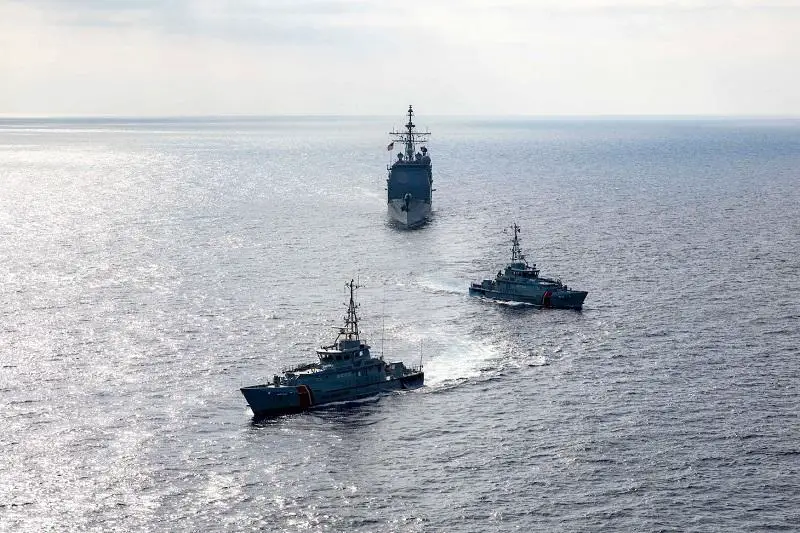Naval Striking and Support Forces NATO (STRIKFORNATO) and U.S. Sixth Fleet (SIXTHFLT) concluded Vigilance Activity Neptune Strike, the eighth phase of NATO’s long-planned Project Neptune series of activities, from STRIKFORNATO headquarters in Oeiras, Portugal, October 28. Neptune Strike demonstrated the combined capacity of the Alliance while underscoring allied and partner nations’ commitments to deterrence and defense of sovereign Alliance territory. This activity and NATO’s wider strategy deters adversaries and terrorist groups from spreading destabilization, widening disorder, or accruing decisive military advantage that would impact allies’ security. While allied and partner aircraft flew together in the skies, the ships of the George H. W. Bush carrier strike group (GHWBCSG) sailed alongside multiple allied ships in the Adriatic and Ionian Seas.
“Neptune Strike sits at the leading edge of NATO’s vigilance activities, providing credible deterrence, and demonstrating the inherent flexibility of the carrier strike group while building high-end interchangeability among our NATO allies and partners on a firm foundation of trust. The energy across the entire Naval Striking and Support Forces NATO team was palpable as we pushed the bounds of allied integration in the land, air and on the seas. I could not be more proud of the teamwork, expertise and professionalism displayed by everyone in making Neptune Strike 22.2 a resounding success. The evolution of Project Neptune is both a testament to the innovation of the NATO Alliance and a tangible demonstration that we truly are stronger together,” said Vice Adm. Thomas Ishee, commander of both SIXTHFLT and STRIKFORNATO.

“Neptune Strike has again offered a perfect opportunity to fully integrate the combat power of a U.S. aircraft carrier into enhanced Vigilance Activity in direct support of NATO’s commitment to deter conflict and defend allies. It has offered the chance to combine capabilities from a large number of nations in all warfare domains – on land, at sea and in the air – as a clear demonstration of allied unity of purpose and cohesion. It has further rehearsed STRIKFORNATO’s role as the primary integrator for U.S. maritime combat power. The George H.W. Bush Carrier Strike Group is now even better prepared to execute complex missions in concert with wider allied efforts to defend the Euro-Atlantic area,” said Royal Navy Rear Adm. James Morley, deputy commander, STRIKFORNATO.
“Neptune Strike 2022 is a perfect example of the transatlantic bond – Europe and North America working together in NATO. NATO’s strength helps to prevent any miscalculation by sending a clear message: NATO will protect and defend every inch of allied territory,” NATO Secretary General Jens Stoltenberg said.
Throughout the two-week long vigilance activity, NATO servicemembers from several allied nations planned, briefed, and executed a variety of specific evolutions, including air-to-land integration with allies including Hungary, Lithuania, North Macedonia, Poland and Slovakia, maritime and interdiction activities, and air-to-air refueling and air-to-air rehearsal events throughout allied airspace. These included Albanian and Croatian ships, as well as members of Allied Maritime Command’s Standing NATO Maritime Group (SNMG) 2 and Standing NATO Mine Countermeasures Group (SNMCMG) 2, and the United Kingdom’s Littoral Response Group (LRG). The diversity and complexity of evolutions conducted during Neptune Strike, through multiple domains and unique scenarios, continued to validate interoperability of a CSG within NATO command and control architectures to contend with a rapidly evolving security environment. The activity is proof of the warfighting advantage that characterizes allied interoperability and, ultimately, the strength of the most successful Alliance in history.

NATO Secretary General Jens Stoltenberg’s visit to the Nimitz-class aircraft carrier USS George H. W. Bush (CVN 77) on Oct. 25 served as a key highlight of the activity. While aboard the ship, Stoltenberg reflected on the carrier’s presence as a demonstration of U.S. capability and commitment to the Alliance, a general escalation of tension between European powers, and how the conclusion of Neptune Strike – and its inclusion of more than 70 aircraft, 20 ships, and 5,000 personnel from 26 NATO allies and partners – demonstrates NATO’s capability on the world stage. Participating nations in Neptune Strike included Albania, Belgium, Bulgaria, Canada, Czechia, Croatia, Denmark, France, Germany, Greece, Hungary, Italy, Latvia, Lithuania, the Netherlands, North Macedonia, Norway, Poland, Portugal, Romania, Slovakia, Spain, Sweden, Türkiye, U.K. and the U.S. Vigilance Activities are day-to-day activities, occurring in all domains and across SACEUR’s area of responsibility, to ensure appropriate strategic awareness and force readiness required to sustain peace.
STRIKFORNATO, headquartered in Oeiras, Portugal, is Supreme Allied Commander Europe’s (SACEUR) premier, rapidly deployable and flexible, maritime power projection Headquarters, capable of planning and executing full spectrum joint maritime operations.
For over 80 years, U.S. Naval Forces Europe-U.S. Naval Forces Africa (NAVEUR-NAVAF) has forged strategic relationships with allies and partners, leveraging a foundation of shared values to preserve security and stability. Headquartered in Naples, Italy, NAVEUR-NAVAF operates U.S. naval forces in the U.S. European Command (USEUCOM) and U.S. Africa Command (USAFRICOM) areas of responsibility. U.S. Sixth Fleet is permanently assigned to NAVEUR-NAVAF, and employs maritime forces through the full spectrum of joint and naval operations.
















